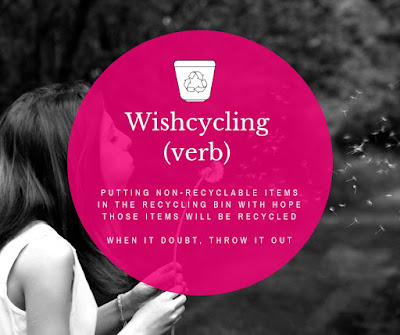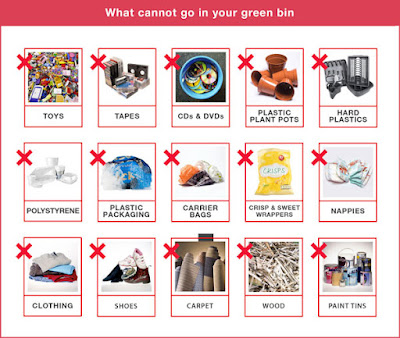
And when you get the goods home from the supermarket, how much of the packaging can go into the recycling? I didn't realise that the triangle of arrows symbol can be used by any manufacturer, and does not guarantee the item can be recycled.
I'm pleased that most supermarkets now have facilities for 'soft plastics' - bread bags, veg bags, soft plastic carriers [not biodegradable ones] And others have bins for water filter cartridges - I noticed our big Sainsburys actually has a collection point for used Teflon pans. All very laudable, but it does mean a lot of sorting, and remembering to take these things when you go out to shop.
Local councils are trying hard to keep people informed about what to put in the recycling bins - and it really does vary from place to place. Some still insist you take glass to a bottle bank - others are happy for it to go in the recycling [unless it is Pyrex, or broken glass] Below is the chart for North Norfolk residents [here in Breckland, green is the ordinary bin, the recycling one is black. I have stenciled huge symbols on the back bin, so our visitors know whats what!]
But it really does depend on where you live. I put some thin wire coathangers in the bin just before we left Dorset [tin foil, drinks cans, hangers - all metal, right?] But apparently that was wrong.
This site has lots of helpful advice. And getting back to those arrows, which have been around for half a century now, created to honour the first Earth Day in 1970
Numbers 1 & 2 are consistently OK for recycling [shampoo bottles etc] 3 through to 7 are the more complicated plastics. These numbers were developed by the plastics industry in the 80s. I have no idea where 9 fits in!Wish-cycling is what we do when
we put materials in the bin with a wink and a
prayer, hoping they will get
recycled but not knowing for sure. Most of us have found
ourselves hovering there for a moment. Can I recycle a crisp packet? What
about a food-splattered napkin? A half full pot of hummus? Wish-cyclers believe that they’re
better off popping the material in, because it’s all headed to
a recycling facility further down the
line. Unfortunately, misplaced optimism when it comes to waste
can have bad consequences.
Wish-cycling causes contamination, which prevents the good stuff getting through. Hand sorting is the first element of the process at most UK facilities. Real
people will work hard to filter out the good quality recyclables
so they can be sent on to make wonderful new things. This job can get
quite tough if the sorting line is full of half-full soup
pots, dregs of lattes in coffee cups or even broken glass
bottles. Essentially wish-cycling doesn’t do
anyone any favours.
Positive steps to take
- Where possible avoid all plastic wrapping
- Think about it before you buy
- Encourage local traders to be more conscientious
- Check your local bin rules
- Find out where other stuff can be recycled
- Please make sure it is clean
- Go to recyclenow.com for more advice
- Encourage others to recycle too.






An excellent post.
ReplyDeleteI have to contend with a lot of wish-recycling at school. I take home the recycling in my bike pannier and last week I had to fish 3 banana skins out of the plastic recycling box and found 3 stinking half tins of soup from the metal recycling bin. It's pure selfishness and laziness in this case rather than wishful thinking. I still clean it out and do the job though because my my inconvenience is less important than trying to help.
Well done Kezzie. We were a little disappointed this summer when we visited Holkham - they had two sorts of bins around the park - regular and recycling - but they weren't clearly marked (IMHO) and people were mixing the rubbish. Plus the bins were overflowing, yet people continued to stuff things in. Worse, if the 'correct' bin was full, they used the others. It seemed such a shame. I suspect you are right, in many cases it is laziness rather than wishfulness...
ReplyDeletewe are big recyclers here in Canada. I know my mam always comments on it when over here. We have two bins, one to put paper in and one to put everything else in. I guess I should do a post about it?
ReplyDeletePlease do - the more people understand what to do, the more they are likely to do it.
DeleteIn and after WW2, my grandmother had a container which was the equivalent of our paper recycle bin, and I loved to look through the old calendars, greeting cards, boxes and so on. I suspect someone with a horse and cart took them away. In Canada I am an avid recycler and I even pick up cans from our roadside and wash them out for the bin.
ReplyDeleteHere the green bins are for organic recycling - and it's usually a blue box for recycling such as cans, bottles & plastic. Then it's the garbage bins for all the rest. We used to have a grey box for all paper and the blue for the rest but I think people got a bit fed up so now all recycling goes into the blue one.
ReplyDeleteWe get a printout in the mail every year reminding us of what goes where and the super in my building also posts it at the elevators and out back by the bins.
It does get tricky in the food courts etc but they are all labelled. It is kind of funny sometimes watching people trying to decide what goes in what bin!
It's the same in our office kitchen, plus each office has a blue bin for paper and shredding. Every little bit helps.
Good to know that you and Bushlady are doing your bit in Canada
DeleteMy dentist has a bin in reception for patients to put their old toothbrushes and tubes!
ReplyDeleteOur Dorset dentist had one of those too.
DeleteI was brought up in a large house, my Grandparents lived in one half, Parents and myself in the other.
ReplyDeleteDue to my Grandparents age, (born 1903 & 1904) it was a household in which clean paper was always folded and kept, newspaper to be scrunched up and dampened for cleaning windows, brown paper for wrapping more or less anything, gift wrapping paper to wrap another gift. String was rolled up and kept too.
In my kitchen cupboards there are several 'tupperware' containers holding string, rubber bands, cords from cagoules etc, and a box under the sink where wrapping paper and paper bags are kept. My vast collection of rubber bands consists mostly of the red bands which our local 'posties' use, they tend to 'twang' off mail and land on the pavements, so I snaffle them, give them a wash and re-use them.
Coffee grounds feed plants in tubs, used teabags are buried in the veg beds.
I recycle envelopes, but cut some cardboard boxes into strips for shopping lists.
We repair anything that can be salvaged, have almost always bought our Grandson wooden toys, not plastic tat, and make our own household cleaning products.
However, nothing can part me from good perfume, and I can't leave the house without hairspray on, but I use natural sprays, not aerosol.
I'm sure I slip up occasionally, but I try to do the right thing!
We don't need one person doing everything right, we need everybody doing some things the right way!
Totally agree, nobody is perfect, but if everybody makes an effort...
Delete